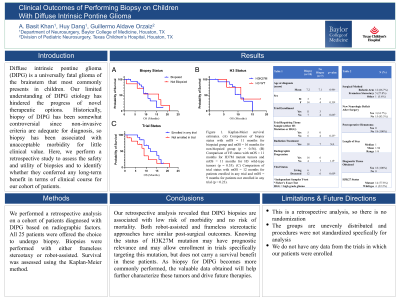Clinical outcomes in biopsy of patients with diffuse intrinsic pontine glioma
Clinical Outcomes in Biopsy of Patients with Diffuse Intrinsic Pontine Glioma
Friday, April 21, 2023


Abdul B. Khan, MD
Resident
Baylor College of Medicine
Houston, Texas, United States
ePoster Presenter(s)
Introduction: Diffuse intrinsic pontine glioma (DIPG) is a rare and aggressive tumor of the central nervous system occurring in pediatric patients with dismal prognosis. Pathophysiology of the tumor is linked to mutations in H3 histone, specifically H3K27M with prognostic relevance. Moreover, tumor biopsy provides opportunity for targeted therapy, but it is not necessary to establish diagnosis. Therefore, we sought to assess the safety of surgical biopsy in DIPG patients as well as its potential impacts on their clinical course.
Methods: Retrospective analysis of patients who met radiological and clinical criteria for diagnosis of DIPG in the last 5 years was performed. We assessed demographic, clinical, radiographic, surgical, and follow-up data.
Results: 25 patients were included; 18 (72%) underwent biopsy while 7 (28%) declined. 12 biopsies (67%) were performed with robotic arm and 5 (27%) with frameless stereotaxy. 3 biopsied patients (17%) experienced new post-operative neurologic deficits including mild ataxia (1), CN VI palsy (1), and CN VII palsy (1). All deficits resolved at 2-week follow-up. There were no other complications. All biopsies yielded diagnostic tissue. Median hospital stay was 1 day and all patients were discharged to their home. 14 patients (78%) had H3K27M mutation. Median OS for H3K27M patients was 10 months. For the wildtype cohort, median OS was not yet reached, suggesting that H3 wildtype patients may have a better prognosis. As an indirect measure of the benefit of possible clinical trial enrollment with tissue diagnosis, we assessed overall survival in biopsy and non-biopsy cohorts but found no significant difference (biopsy median OS 8.5 months, non-biopsy 9 months).
Conclusion : In our series, DIPG biopsies carried low risk of complication. Presence of the H3K27M mutation trended worsened survival, therefore knowing H3K27M status may be of value to patient families. There was no difference in survival between biopsy and non-biopsy patients.
Methods: Retrospective analysis of patients who met radiological and clinical criteria for diagnosis of DIPG in the last 5 years was performed. We assessed demographic, clinical, radiographic, surgical, and follow-up data.
Results: 25 patients were included; 18 (72%) underwent biopsy while 7 (28%) declined. 12 biopsies (67%) were performed with robotic arm and 5 (27%) with frameless stereotaxy. 3 biopsied patients (17%) experienced new post-operative neurologic deficits including mild ataxia (1), CN VI palsy (1), and CN VII palsy (1). All deficits resolved at 2-week follow-up. There were no other complications. All biopsies yielded diagnostic tissue. Median hospital stay was 1 day and all patients were discharged to their home. 14 patients (78%) had H3K27M mutation. Median OS for H3K27M patients was 10 months. For the wildtype cohort, median OS was not yet reached, suggesting that H3 wildtype patients may have a better prognosis. As an indirect measure of the benefit of possible clinical trial enrollment with tissue diagnosis, we assessed overall survival in biopsy and non-biopsy cohorts but found no significant difference (biopsy median OS 8.5 months, non-biopsy 9 months).
Conclusion : In our series, DIPG biopsies carried low risk of complication. Presence of the H3K27M mutation trended worsened survival, therefore knowing H3K27M status may be of value to patient families. There was no difference in survival between biopsy and non-biopsy patients.
